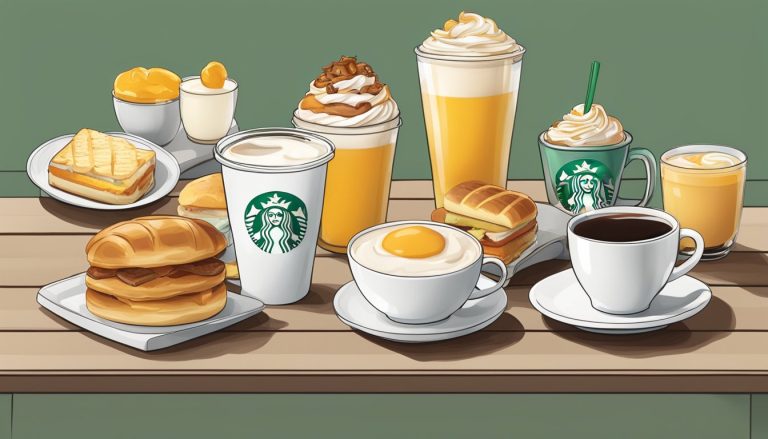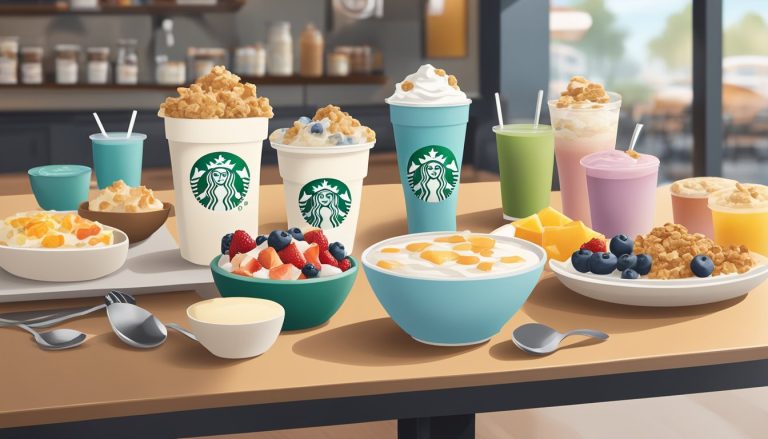Starbucks has mastered the art of breakfast economics, carefully balancing pricing strategies with profitability. The coffee giant’s approach to morning offerings reflects a deep understanding of consumer behavior and market dynamics.
Starbucks’ breakfast menu pricing aims to maximize profits while maintaining customer appeal, with options ranging from premium items to value-oriented “pairings” at $3.95. This tiered strategy allows the company to cater to various customer segments, from those seeking a quick, affordable bite to those willing to splurge on higher-end options.
The economics behind Starbucks’ breakfast menu extend beyond simple pricing. The company leverages its strong brand position and customer loyalty to command higher prices than many competitors. By offering unique, high-quality products and emphasizing the “Starbucks experience,” the company justifies its premium pricing while maintaining a strong profit margin on breakfast items.
Starbucks: A Coffeehouse Giant
Starbucks has become synonymous with coffee culture worldwide. The company’s success stems from its distinctive brand identity and dominant market position.
Brand Identity and Perception
Starbucks’ brand identity revolves around premium coffee and a unique customer experience. The company’s iconic green logo is recognized globally, representing quality and consistency. Starbucks stores offer a “third place” between home and work, fostering a sense of community.
The brand emphasizes ethical sourcing and sustainability, appealing to environmentally conscious consumers. Starbucks’ mobile app and rewards program enhance customer loyalty and convenience. These elements contribute to a strong brand value, estimated at $13.7 billion in 2022.
Market Position and Competition
Starbucks leads the global coffeehouse market with over 35,000 stores in 80 countries. Its main competitors include Dunkin’ Donuts, Costa Coffee, and local chains. Starbucks maintains its edge through product innovation and expansion into new markets.
The company’s premium pricing strategy reflects its upscale positioning. Starbucks faces challenges from independent coffee shops and fast-food chains offering lower-priced alternatives. To stay competitive, Starbucks continually introduces new products and invests in store redesigns.
Starbucks’ leadership focuses on balancing growth with maintaining brand integrity. The company’s adaptability to local tastes while preserving core values has been crucial to its global success.
Analyzing Starbucks’ Pricing Strategies
Starbucks employs sophisticated pricing strategies to maximize profitability while maintaining customer satisfaction. The company utilizes value-based pricing, premium positioning, and targeted promotions to optimize revenue across its product lines.
Fundamentals of Value-Based Pricing
Starbucks implements value-based pricing by aligning prices with perceived customer value. This approach allows the company to charge premium rates for high-quality coffee and unique beverage creations. Starbucks considers factors like ingredient quality, preparation methods, and store ambiance when setting prices.
The company also adapts pricing to local markets, adjusting for regional income levels and competition. In urban centers, prices tend to be higher due to increased operating costs and higher willingness to pay.
Starbucks carefully analyzes price elasticity for different products. Core items like basic brewed coffee have relatively elastic demand, while specialty drinks often have more inelastic demand, allowing for higher markups.
Premium Pricing Approach
Starbucks positions itself as a premium coffee brand, justifying higher prices through quality and experience. The company’s pricing reflects this upscale image across its product range.
Specialty drinks and limited-time offerings often carry the highest premiums. These unique creations allow Starbucks to showcase its innovation and command top dollar from customers seeking novel experiences.
Seasonal items, like the popular Pumpkin Spice Latte, typically carry premium pricing. Starbucks leverages scarcity and exclusivity to drive demand for these products despite their higher cost.
Discounts and Promotional Activities
While maintaining its premium image, Starbucks strategically uses discounts and promotions to drive sales and customer loyalty. The Starbucks Rewards program offers members periodic discounts and free items, encouraging repeat visits and larger purchases.
Happy Hour promotions provide time-limited discounts on specific menu items, helping to boost sales during slower periods. These offers are often tailored to introduce customers to new products or drive traffic at specific times.
Starbucks also runs seasonal promotions tied to holidays or events. These targeted campaigns help create buzz and attract price-sensitive customers who might not regularly visit Starbucks.
Profitability and Cost Considerations

Starbucks carefully balances revenue streams, profit margins, and operational costs to maintain profitability in its breakfast offerings. The company focuses on optimizing input costs and efficiency while maximizing sales.
Revenue Streams and Profit Margins
Starbucks generates significant revenue from its breakfast menu items. Coffee and espresso drinks typically yield high profit margins, often exceeding 80%. Food items like pastries and sandwiches have lower margins, usually between 15-20%.
The company uses premium pricing for its coffee drinks, positioning them as luxury items. This strategy allows Starbucks to maintain healthy profit margins despite fluctuations in commodity prices.
Breakfast pairings, such as a coffee and food combo for $3.95, aim to boost overall sales volume. While these deals may slightly reduce per-item margins, they can increase total revenue by encouraging larger purchases.
Input Costs and Operational Efficiency
Coffee beans represent a major input cost for Starbucks. The company mitigates price volatility through long-term contracts with suppliers and strategic inventory management.
Labor costs are another significant expense. Starbucks invests in training and technology to improve employee efficiency and reduce waste. Automated espresso machines and streamlined food preparation processes help minimize labor costs.
Food waste is carefully managed through demand forecasting and inventory control systems. This helps Starbucks maintain fresher products while reducing losses from unsold items.
Energy-efficient equipment and store designs help lower utility costs. These initiatives not only reduce expenses but also align with Starbucks’ sustainability goals.
The Role of Technology and Innovation

Starbucks leverages technology and innovation to drive growth, enhance efficiency, and improve customer experiences. The company invests heavily in digital solutions and pioneering concepts to maintain its competitive edge in the coffee industry.
Technological Investments and Disruption
Starbucks has made significant technological investments to disrupt traditional coffee shop operations. The company implemented a mobile order and pay system, allowing customers to place orders and make payments through their smartphones. This innovation reduces wait times and improves operational efficiency.
Starbucks also utilizes artificial intelligence to optimize inventory management and predict customer demands. The company’s AI-powered system analyzes sales data, weather patterns, and local events to ensure stores are adequately stocked.
In-store technology upgrades include digital menu boards and automated espresso machines. These investments streamline operations and maintain consistency across locations.
Innovations Enhancing Customer Experience
Starbucks continually introduces innovations to elevate the customer experience. The Starbucks Rewards program, integrated with the mobile app, offers personalized recommendations and exclusive benefits to loyal customers.
The company has experimented with concept stores, such as the Starbucks Reserve Roasteries. These locations showcase premium coffee experiences and cutting-edge brewing methods.
Starbucks has also embraced sustainability through innovative packaging solutions and energy-efficient store designs. These efforts appeal to environmentally conscious consumers and reduce operational costs.
Voice ordering capabilities have been integrated into the Starbucks mobile app, allowing customers to place orders hands-free. This feature enhances convenience and accessibility for users.
Enhancing Customer Engagement and Loyalty

Starbucks employs several strategies to foster customer loyalty and boost engagement. These efforts aim to increase repeat visits and strengthen connections with their customer base.
Loyalty Program Success Factors
Starbucks Rewards is a key driver of customer loyalty. Members earn “stars” for purchases, redeemable for free drinks and food items. The tiered system encourages increased spending to reach higher status levels.
Digital integration enhances the program’s effectiveness. The Starbucks mobile app allows easy star tracking, reward redemption, and mobile ordering. This convenience factor incentivizes frequent use.
Personalized offers based on purchase history further entice members. Birthday rewards and double-star days create excitement and urgency to visit.
Customer Engagement Tactics
Mobile ordering is a cornerstone of Starbucks’ engagement strategy. It reduces wait times and allows for precise customization, enhancing the overall experience.
Seasonal menu items and limited-time offers generate buzz and drive traffic. These promotions often tie into cultural moments or holidays.
Starbucks leverages social media to connect with customers. User-generated content campaigns encourage sharing and foster community.
In-store experiences, like barista name-writing and customized drink options, create personal touches that resonate with customers.
The Economics of Coffee and Customer Behavior
Coffee economics intertwine market forces with consumer psychology. Pricing strategies and spending patterns shape the industry’s landscape, influencing both business decisions and customer choices.
Coffee Market Dynamics
The global coffee market fluctuates based on supply and demand. Factors like weather conditions, geopolitical events, and currency exchange rates impact coffee bean prices. Starbucks, as a major player, influences and responds to these dynamics.
Large coffee chains often use futures contracts to lock in prices, protecting against market volatility. This strategy allows them to maintain consistent pricing for customers despite fluctuations in raw material costs.
Quality differentiation plays a crucial role. Specialty coffee commands premium prices, reflecting consumers’ willingness to pay more for perceived higher quality and unique flavor profiles.
Consumer Spending Patterns and Price Sensitivity
Coffee drinkers exhibit varying degrees of price sensitivity. Regular consumers often develop brand loyalty, making them less responsive to small price changes. However, economic downturns can shift spending habits.
Disposable income significantly affects coffee consumption patterns. During economic booms, consumers may splurge on premium coffee drinks. In contrast, tighter budgets might lead to trading down or reducing frequency of purchases.
Starbucks employs tiered pricing strategies to cater to different consumer segments. This approach allows them to capture value across various price points, from basic brewed coffee to elaborate specialty beverages.
Seasonal promotions and loyalty programs influence spending behaviors. These tactics aim to increase customer visits and average transaction values, boosting overall sales and fostering long-term brand attachment.
Financial Performance and Future Outlook

Starbucks faces economic headwinds but remains focused on strategic growth initiatives. The company’s recent financial results and leadership vision provide insights into its economic trajectory and plans to maintain market leadership.
Analyzing Recent Financial Reports
Starbucks reported mixed financial results in Q3 FY24. Revenues declined 0.6% year-over-year to $9.11 billion. Comparable store sales dropped 3% due to lower transaction volumes and ticket sizes.
Net income figures were not provided in the search results. However, the decline in sales suggests potential pressure on profitability.
The U.S. market experienced a 3% drop in sales, marking the steepest fall in years outside of major economic events. This indicates challenges in Starbucks’ core market.
Strategic Planning for Long-Term Growth
Starbucks is navigating economic volatility through strategic initiatives. The company continues to invest in its premium brand positioning despite risks during economic downturns.
Key focus areas include:
- Digital engagement
- Product innovation
- Store expansion in high-growth markets
- Supply chain optimization
Starbucks aims to leverage its brand strength and pricing power to drive future growth. The company’s attractive unit-level economics provide a foundation for expansion.
CEO Brian Niccol’s Vision
Note: The search results do not contain information about Brian Niccol as Starbucks’ CEO. This appears to be an error in the prompt. The current CEO of Starbucks is Laxman Narasimhan.
Laxman Narasimhan, who became CEO in 2023, is steering Starbucks through economic challenges. His vision focuses on:
- Reinventing the store experience
- Expanding global reach
- Enhancing digital capabilities
Narasimhan emphasizes the importance of innovation and customer connection. He aims to balance short-term performance with long-term strategic investments.
The CEO’s approach prioritizes sustainable growth and maintaining Starbucks’ position as a premium coffee brand.




